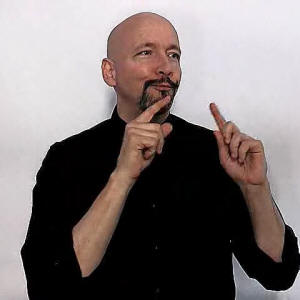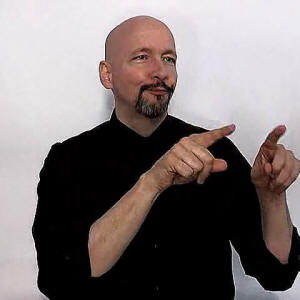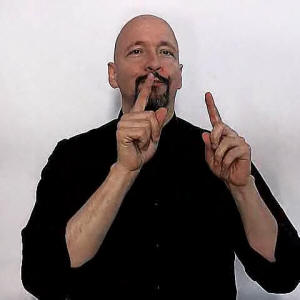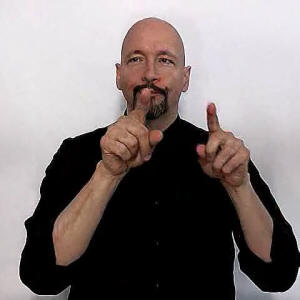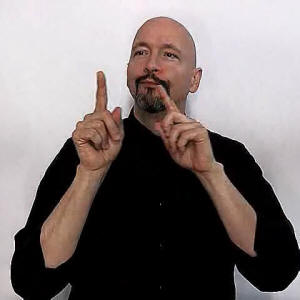American Sign Language:
Pluralizing: Creating plurals in ASL
Some methods of pluralizing:
1. Use a number
2. Incorporate a number into the sign
3. Use a quantifier such as "MANY, FEW, SEVERAL"
4. Use a classifier such as "SCADS-OF"
5. Use with a phrase: STORE, I GO-to, (shift) GO-to, (shift) GO-to.
6. Sweep
7. Reduplication
8. Inflection of the movement (e.g. people)
9. Reposition
PERSONAL PRONOUNS:
Pronouns that are used as substitutes for proper or common nouns can be pluralized by sweeping. Typical examples include: "I, we, you, he, she, it, they."
For example the concept of "THEY." I would point slightly off to the right and sweep it more to the right. Of course if the people are present then you can simply point to them.For "YOU ALL" I would point slightly to the left and sweep to the right. The more people there are the bigger the sweep.
Question from a student: "Does the sweep always move horizontally?"Answer: It depends on what you are talking about. If I am talking about a group that is organized vertically then I will sign (sweep) from top to bottom in an vertical motion. For example if I'm referring to items in a list, or a stack of items.
Noun signs and their plural forms:
Question: A researcher asks:
I am aware of the fact that in most cases ASL noun plurals are expressed by just putting a numeral or quantifier like MUCH or MANY in front of the noun to be pluralised. I have also read (in Wilbur 1987 and Supalla & Newport 1978) that sometimes, plural can be expressed directly on the noun, by repeating the noun sign a couple of times, or in the case of two objects, using the "dual inflection" where the noun sign is repeated once and the body shifts from one side to the other. I suppose this way of plural marking isn't very frequent, but do you have an intuition when it is more likely to occur? Maybe there are contexts when it occurs more often than in others, and to elicit these plural forms I could try to build up such a context.
I am not referring to dual or plural inflection on the VERB but to pluralisation of the NOUN itself. By pluralisation I actually mean all the different ways there are of marking a noun directly for plural, i.e. not via quantifiers and numerals but through duplicating the noun sign, duplicating it with a body shift, or whatever other way of plural marking on nouns there is that I am not aware of. Could you tell me about contexts where nouns can be directly marked for plural in ASL?Answer: Bill replies:
The ways of directly marking the noun would include:
* Sweep: HE becomes THEY / IT becomes THOSE
* Inflection of the movement: PERSON becomes PEOPLE
* Reduplicate: ADOPT vs ADOPTIONS, TEACH vs TEACHINGS, CANCEL vs CANCELATIONS
* Reposition: CL:3 (vehicle) becomes "A car here, one here, and one here" via repositioning.
Reduplication in the same location tends to occur when you turn a process into a pluralized noun. TEACH is a process. TEACHINGS are nouns. CANCEL is a process, CANCELATIONS are nouns. This is certainly related to "noun/verb" pairing, but there is a subtle difference. We do not reduplicate the sign "ADOPT" to mean "ADOPTION." We either rely on context, we add some other sign such as "PROCESS," and/or we add a mouth morpheme.Thus there are verbs that when reduplicated become plural nouns.
Note: You asked how to elicit examples.
To elicit examples of various noun usage I suggest you show your language models videos of plural nouns and ask the models to describe what they saw. For example you could show a video of a car accident involving multiple cars and ask them to retell what they saw.
2008/8/14 Bill writes:
Cornelia
Are you from Europe? You are spelling pluralisation with an "s." My spell check tends to use a "z" (e.g. pluralization.) Are you doing your dissertation? Writing a book? Got me curious now.
In a message dated 8/14/2008 11:21:19 A.M. Pacific Daylight Time, cornelia.loos writes:
Hi Bill,
I am indeed from Europe, specifically from Germany, and I've adopted the 's' for any -ise and -isation words cause that way I don't get muddled up with z and s and just keep it consistent.
I am writing my undergrad thesis on compound formation in ASL, and thanks a lot for putting the note up on your page. Unfortunately, I don't have any process nouns among the nouns I'm testing. The idea behind my asking for pluralisation of nouns is that I want to look at headedness in ASL nominal compounds, and one characteristic of a head (the more prominent element of a compound, e.g. 'house' in 'greenhouse') is that it takes plural marking. So one way of proving that e.g. the formal head of the compound BOOK^SHELF is the sign SHELF is by showing that plural marking on more than one BOOK^SHELF goes onto the sign SHELF, e.g. by signing several shelves next to each other or below each other. I am indeed using pictures to elicit the compound nouns in question, but for lots of them I fear native signers won't reduplicate the noun to show pluralisation, e.g. BABY^COW, JESUS^BOOK, MUSIC^GROUP, DEATH^ARTICLE; BOAT^PADDLE, COAT^HOOD; SKIN^YELLOW, MEDICINE^CALM-DOWN. So my question earlier was aiming at getting contexts where signers would reduplicate the heads of the signs just mentioned to indicate plural.
I hope my explanations is clear, I'm kind of tired - I've been packing all day cause I'm flying to Toronto in a few days to interview native signers :)
Thanks for your interest and help,
Cornelia
Cornelia,
Your explanations are really very good. Especially the most recent one.
I can indeed see your challenge and I suspect there is no "easy" solution, but since you've asked for help in brainstorming I'll suggest the following:
It seems to me that you might want to try asking your models to "exhaust" their repertoire of variations by showing you "every" way they can think of to describe what is in the picture or video. Thus they will end up showing you many variations and hopefully include the variations you are looking for. Then, afterward you can ask them to discuss which ones "feel" best. And then you can ask them to specifically comment on the items you are seeking to explore.
--Bill
In a message dated 8/27/2010 10:47:19 A.M. Pacific Daylight Time, Eben writes:
I was looking at your website for information about making inflected plurals. You mentioned one excellent example: PERSON - PEOPLE. I cannot think of any others. Do you know any more?
Regards,
Eben-------------
Dear Eben,
In a way, SWEEP (using a sweeping motion with certain signs) is a form of inflecting a sign to make it plural.
Ask yourself, are we creating plural forms in the following example?
HE/SHE becomes THEY
MONDAY becomes every-MONDAY
MORNING becomes every-MORNING
TREE becomes FOREST
You might think, "Well, those aren't really plurals."
What if we tweak the English words that we use for those concepts?
For example:
THEY becomes "those individuals"
Every-MONDAY becomes "Mondays" as in "On Mondays I go to the store."
Every-MORNING becomes "mornings" as in "On Monday mornings I go to the store."
FOREST becomes "trees."
All of the sudden we now have "plurals" in the traditional sense.
Thus I think that there are many "hidden" plurals in ASL that people don't immediately recognize as plurals.
For example, ask yourself this: "Is the sign 'WE' a plural form of the sign "ME"?
Cordially,
Bill---------------
In a message dated 8/27/2010 11:19:28 P.M. Pacific Daylight Time, Eben writes:
Hello Bill:
Thank you for your prompt and considered reply.
Yes, "sweep" is definitely one of the plurals that we count and teach--
HE+++ = THEY
I + HE + HE + HE + ME = WE
HOUSE +++ = CITY
HOUSE (replaced with CL:A +++) + sweep = ROW OF HOUSES
BICYCLE (replaced with CL:3) + sweep = ROW OF BICYCLES
I like your examples, too. Any early student would find these to be very helpful.
What I am looking for is more specific. I am sorry that I did not make myself clear the first time. It is a little tricky to explain, even now, but I will try.
When you want to Sign PEOPLE, you do not reduplicate the root-- as we generally would do. Rather you replace the Sign for PERSON with a separate existing Sign that means the plural of that. (As we do in English. Mice is replaced with MOUSE. We don't says MOUSES. MOUSE and MICE are two compleatly different words that would be found on different pages in a lexicon.) There is one gloss for the singular and another separate gloss for the plural. I don't know of any other case of this happening, and our students want to know if we can find one.
I know that you are a stickler for detail, as am I. Arguably, it seems that PEOPLE did come from PERSON +++ originally-- though, in my experience, the Sign is generally reversed. (I know that some Signers do it forward, and the argument suggests that we really should. But most of the Signers that I have known do not.)
Can you think of any other example of making a plural where you use an entirely different Sign other than the root Sign? Does this technique have a different name than "inflected"?
Can you list every way of making plurals? I have come-up with twelve. What say ye?
...
Eben------
Dear Eben,
In order to claim that PEOPLE doesn't replicate the "root sign" PERSON, we have to first clearly define what we mean by "root sign."
Each sign is an articulatory bundle consisting of shape, location, movement, orientation, facial expression, holds, and movements. Plus, we could even include mouth morphemes (or absence of MMs), head tilts (or absence of HTs), shoulder raises (or absence of SRs), body twists (as in role shift, or absence of BTs), and eye gaze.
How shall we define a "root sign?"
Well let's start by defining a "root word."
"A root word is the basic linguistic unit of a word, the form of a word after all affixes are removed." (wiki.answers.com, 2010).
So then can we define a root sign as: "A root sign is the basic linguistic unit of a sign, the form of a sign after all affixes are removed?"
Woah...now we need to define an "affix" in ASL.
Again, starting with "words" we get: An affix is a morpheme that is attached to a word stem to form a new word." (en.wikipedia.org/wiki/Affix, 2010)
But wait, do affixes always have to be attached? You would think so. The word "affix" generally means "attach to."
However there is such a thing as a "separable affix."
(See: http://www.sil.org/linguistics/GlossaryOfLinguisticTerms/WhatIsASeparableAffix.htm)
Anyway, let's drag the discussion back to "root signs."
An aspect (such as the "movement") of a root sign can be changed to create a new meaning.
When we change the meaning of a sign by altering its movement we refer to that "change" an "inflection."
When we change the meaning of a sign by attaching a form morpheme to the root word we call that an "affix."
How do we know if two signs are different/separated signs or if they are actually a root and a conjugate (a sign which is a form of another sign)?
If through the process of inflection or affixation we create a new sign with a new meaning that is closely related to the meaning of the root sign, and if many of the remaining aspects of the articulatory bundle (handshape, location, orientation, etc.) of the new sign are very similar to that of the root sign we would likely consider the new sign to be a form of (or an inflection of, or a conjugation of) the root sign. Thus the new sign would not be a different/separate sign.
Most people consider the differences between the English words "mouse" and "mice" to be substantial enough to consider them two different words. The meanings are very similar but the form is different enough for mice to be considered a different word from mouse. We did not add a form morpheme such as "s." We did not add a process morpheme such as stressing a different syllable in the word. What we did is we replaced more than one of the forms (letters) in the word with other forms.
Can we say that PEOPLE is really a separate sign from "PERSON?"
Consider:
1. The meanings of the two signs (PERSON and PEOPLE) are very similar.
2. The articulatory bundles of the two signs are very similar.
3. We are not changing the forms in the sign. (Handshapes) (Unless you use the non-initialized form of PERSON.)
4. We are changing the process of articulating of the sign. (Movement)
Is PEOPLE any more separate from PERSON-(initialized form) than "FOREST" is from TREE?
Thus it would seem that PEOPLE is just a form of PERSON and is not a "different sign."
Should we grant "PEOPLE" its own "pluralization" category of "replace with a different sign?" It seems more likely that PEOPLE is simply using a type of "sweep pluralization" and that particular type of sweep pluralization is simply the type of movement that works best for root signs such as PERSON that are two-handed and have vertical movement.
If that is true, the question remains, "Does ASL have examples of pluralization equivalent to the English method of pluralization that replaces a word such as mouse with a new word such as mice?"
I ask that question to my wife. Then I signed to her "sunset" and then I looked up and used 2 hands in "4 handshapes"-with curved-fingers and I made small arching movements to dot the sky with "stars." She knew immediately what the sign meant. I was able to convey the meaning of "STARS" using a sign that is substantially different from the sign "STAR." She said that I was "cheating" by using a classifier and that it wasn't actually a different sign. I'm assuming that she meant I was using a classifier as a quantifier. And she is right, I was. I used context (sunset) and eye-gaze to imply that to which I was referring. And then I used a classifier which she inferred meant "stars."
So, the search for "pluralization via replacement" goes on.
Luck to us all.
-- Bill
--- On Sat, 8/28/10, BillVicars@aol.com <BillVicars@aol.com> wrote:
From: BillVicars@aol.com <BillVicars@aol.com>
Subject: Re: to Dr. Vicars-- need 411 about ASL inflected plurals
To: cldeafs@yahoo.com
Date: Saturday, August 28, 2010, 12:45 AM
In a way, SWEEP is a form of inflecting a sign to make it plural.
Ask yourself, are we creating plural forms in the following example?
HE/SHE becomes THEY
MONDAY becomes every-MONDAY
MORNING becomes every-MORNING
TREE becomes FOREST
You might say, "Well, those aren't plurals."
What if we tweak the English words that we use for those concepts?
For example:
THEY becomes "those individuals"
Every-MONDAY becomes "Mondays" as in "On Mondays I go to the store."
Every-MORNING becomes "mornings" as in "On Monday mornings I go to the store."
FOREST becomes "trees."
All of the sudden we now have "plurals" in the traditional sense.
Thus I think that there are many "hidden" plurals in ASL that many people don't think of as plurals until they are converted to an equivalent English phrase that looks like a "traditional plural."
Cordially,
Bill
In a message dated 8/27/2010 10:47:19 A.M. Pacific Daylight Time, cldeafs@yahoo.com writes:
Hello Dr. Vicars:
I was looking at your website for information about making inflected plurals. You mentioned one excellent example: PERSON - PEOPLE. I cannot think of any others. Do you know any more?
Thank you SO MUCH for your website. We really like your style. And it is plain to see the level of commitment that you make to education. One has to wonder when you sleep! Keep up the good work.
Regards,
Eben
If you sign "STORE" and then do the sign GO-to several times in different directions it will cause the concept of "STORE" to become plural (STORES) and will mean something to the effect of: I went to several different stores:
You can learn American Sign Language (ASL) online at American Sign Language University ™
ASL resources by Lifeprint.com © Dr. William Vicars
